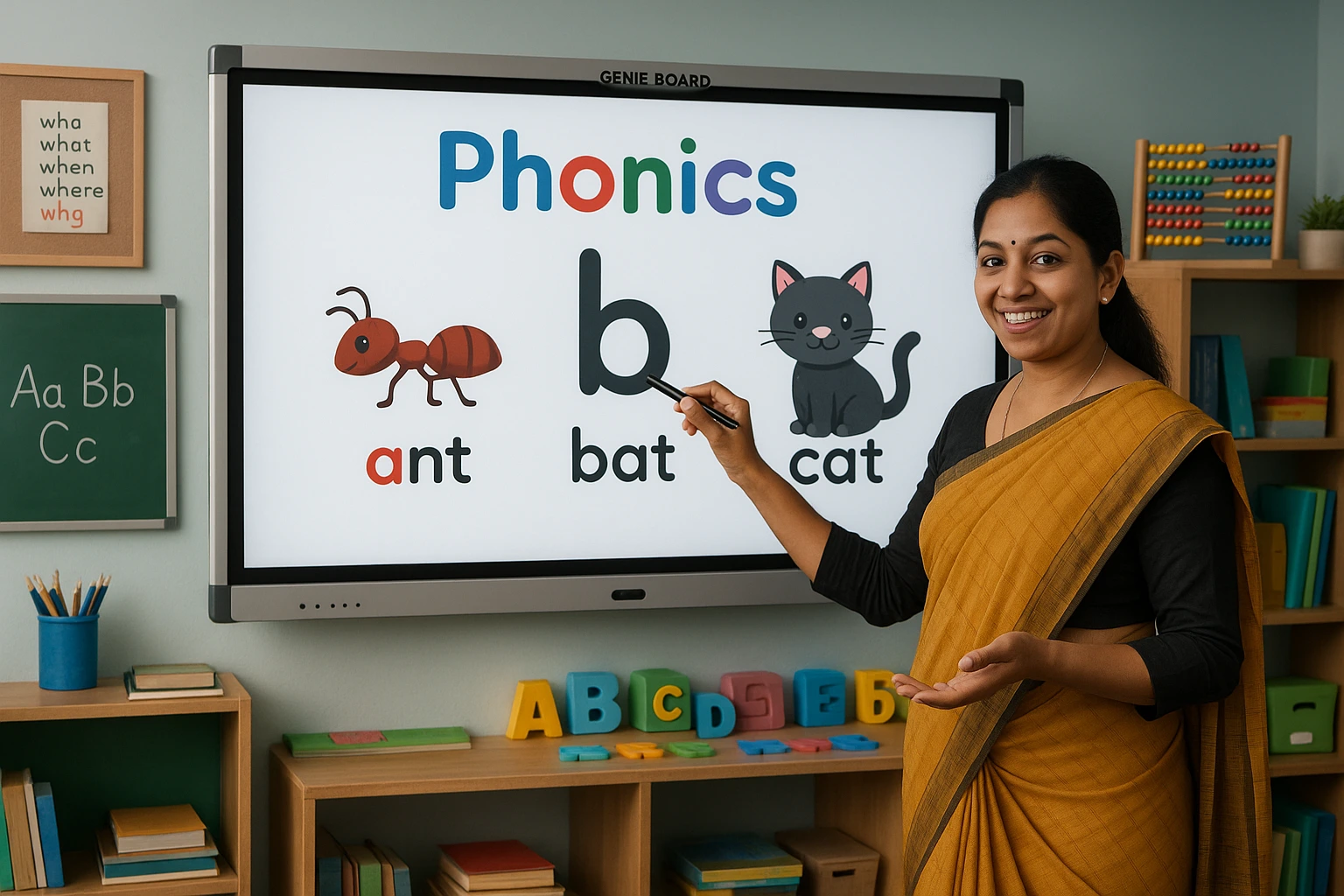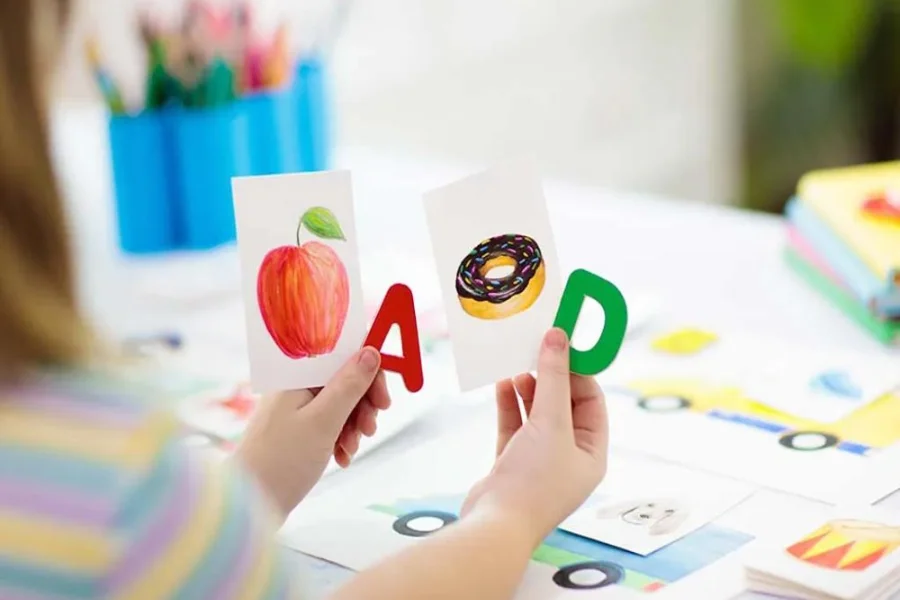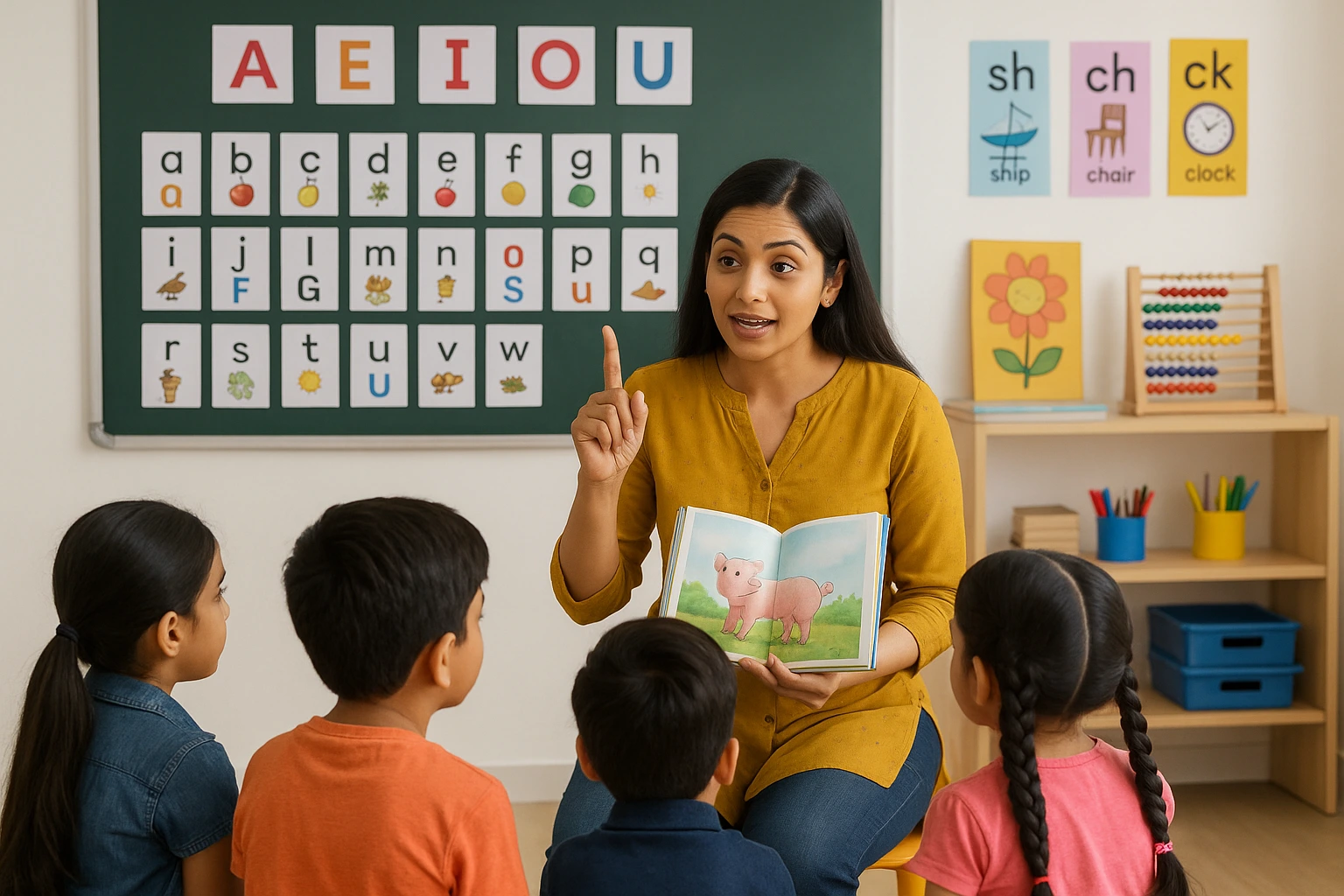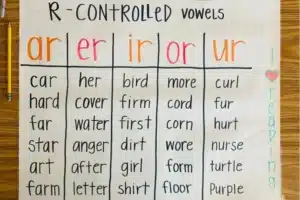
Phonics for UKG helps children associate letters with their sounds, thus making it an indispensable part of early learning. It builds a strong base for future reading skills by helping kids read basic words by blending sounds. A well-structured Phonics for UKG Class Syllabus includes letter-sound recognition, vowel and consonant blends, digraphs, and introductory word formation. This Phonics for Class Syllabus makes learning entertaining and helps children gain confidence in reading through routine practice and playful interaction.
What is UKG Syllabus?
The UKG (Upper Kindergarten) syllabus is planned to build a robust basis in literacy, numeracy, and preliminary life skills through systematized activities and functional learning. It focuses on enhancing language, improving motor skills, fostering early cognitive proficiency, and promoting social interaction. A key aspect of this stage is training children for formal education.
UKG Class Syllabus for English, as per CBSE guidelines:
The English UKG Syllabus comprises various topics and activities that support early reading, writing, listening, and speaking aptitudes:
- Letters (Aa–Zz)
- Articles: A / An
- Identification and naming of letters and objects
- One-Many (Singular and Plural)
- Positions (e.g., in, on, under)
- Rhyming words
- Sound of each letter
- This–That & These–Those
- Vowel words and introduction to vowels and consonants
- Reading simple words and sentences
- Engaging in basic social conversations
Learning Methods Used:
- Use of Genie Board for interactive sessions
- Flashcards for visual memory and word recall
- Oral interaction to improve speaking and listening
- Written work to develop writing practice
- Worksheets for reinforcing concepts
- Storytelling and enactment to boost imagination and language use
- Picture composition activities
- Making sentences using specific words or structures
- Regular revision of the English language basics
The focus of the UKG Syllabus is to create a balanced learning environment where children can grow in confidence while developing essential language skills at their own pace.
To Download Brochure of Phonics Course, Click Here!
For more details of Phonics Course Call / Whatsapp +919869866277 / +919869546913

Source: toddlerjunction
How to Teach Phonics for UKG Students?
Teaching Phonics for UKG Students needs a vibrant, dynamic, and methodical approach. The Phonics for UKG Class Syllabus should concentrate on helping students comprehend letters and sounds and gradually blend those sounds to read basic words.
Effective Ways to Teach Phonics for UKG Students:
- Start with Letter Sounds: Before focusing on letter names, teach children the letter sounds. Use jingles, activities, and pictorial aids to make the sounds unforgettable.
- Use Flashcards and Charts: Exhibit alphabet flashcards with related images, like- A for Apple, to support sound recognition.
- Familiarize Consonants and Vowels: Help children recognize consonants and vowels using simple and creative Phonics for UKG activities.
- Blending Practice: Once students comprehend individual sounds, familiarize words that consist of a consonant, a vowel, and a consonant (CVC words). Blend sounds like b-a-t or h-u-t aloud with them.
- Use Rhymes and Songs: Rhyming words and phonics jingle songs are wonderful tools to build sound understanding.
- Storytelling: Use brief stories that highlight specific sounds or digraphs. Let children listen and repeat key words.
- Integrate Pictorial and Tactile Tools: Genie boards, magnetic letters, and sand trays help children form and identify sounds while staying entertained.
- Introduce Digraphs Slowly: Teach common digraphs like ‘sh’, ‘ch’, and ‘th’ with plenty of illustrations and repetition.
- Sentence Formation Practice: Facilitate students to build simple sentences using everyday Phonics for UKG words to enhance reading confidence.
- Strengthen Learning with Worksheets: Routine worksheets that involve matching, coloring, and outlining help support daily lessons.
- Everyday Revision and Oral Drills: Short revision sessions each day help strengthen memory and pronunciation.
Forming a cheerful, interactive atmosphere makes Phonics for UKG a delightful experience. When taught with patience and creativity, Phonics for UKG can set the ground for robust reading aptitudes in early learners.
What Should UKG Students know in English?
Children, when they reach UKG, are expected to have built primary communication skills and a growing understanding of the English language. The objective at this stage is to develop reading enthusiasm, vocabulary, listening comprehension, and sentence structure through routine activities and significant interaction.
Let us have a look at What Should UKG Students know in English:
- Phonics Basics
- Articles and Grammar Use
- Vocabulary Building
- Rhyming and Word Families
- Simple Sentences
- Picture Description
- Positional Words
- Listening and Comprehension
- Conversation Skills
- Storytelling and Recitation
Learning should be promoted through regular reading, Phonics for UKG games, role-plays, and structured interaction, which boost children’s interest in knowing the language.

How to Teach a Child English at Home?
Teaching a Child English at Home can be a joyful experience. Parents can use the friendly and supportive home environment to help their children build rich language skills. Using Phonics for UKG, storytelling, plays, and simple conversations can form a solid basis for reading, writing, and expressing.
Teach a Child English at Home using the following practical ways:
- Initiate with Casual Conversations: Use easy English sentences during everyday practices like eating or playing, to build ease with the language.
- Acquaint Letters and Sounds: Start with the alphabet and its sounds. Concentrate on Phonics for UKG-based understanding to help children associate letters with sounds.
- Use Flashcards and Picture Books: Visuals help children relate words to images, making it more straightforward to recognize and comprehend.
- Read Aloud regularly: Reading short descriptions aloud promotes listening skills, vocabulary, and enunciation.
- Foster Singing Rhymes and Songs: Rhymes help children retain new words and enhance their sound recognition playfully.
- Practice with Simple Worksheets: Engross children with outlining, matching, and complete-the-blank exercises for letters and basic Phonics for UKG words.
- Create Word Games: Games like word bingo, phonics riddles, or letter quests make learning entertaining and interactive.
- Focus on Phonics: Teaching Phonics for UKG helps children comprehend the structure of words and how to interpret them.
Parents who want to teach their child English using phonics methods can consider becoming a part of the Phonics Teacher Course by Vidhyanidhi Education Society (Govt. Regd.). This Phonics Course prepares grown-ups with tools to teach Phonics for UKG and develop early reading skills.
The Phonics Teacher Course is excellent for aspiring educators and parents who wish to support their child’s early language expansion at home using Phonics for UKG. By joining the Phonics Teacher Course, parents learn to guide their child’s English learning journey in a structured and practical manner.
Choose Vidhyanidhi Education Society and Master Phonics Teaching with confidence!
To Download Brochure of Phonics Course, Click Here!
For more details of Phonics Course Call / Whatsapp +919869866277 / +919869546913
FAQs
How is Phonics taught in Early Years?
Phonics is taught using blending, rhymes, and activities that help children associate letters with sounds.
Can we Skip LKG and join UKG?
It counts on the child's readiness and the school’s policy. Some schools may permit it following a primary skills assessment or age-appropriate evaluation.
Which Age is Best for UKG Students?
The ideal age for UKG is 5 to 6 years. At this stage, children are developmentally ready for structured learning. Vidhyanidhi Education Society follows this guideline.



